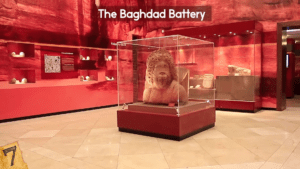Embark on a journey through time as we unveil the most mysterious artifacts ever discovered—relics that challenge the way we perceive history itself. From detailed maps ahead of their time to lost civilizations in China, these artifacts have left researchers and historians baffled. Here are eight extraordinary discoveries that continue to mystify and intrigue:

**8. The Piri Reis Map: A Cartographic Enigma**
*Year: 1513*
The Piri Reis Map, created by Ottoman admiral Piri Reis, stands as the first-known map of the world. Crafted on gazelle-skin parchment, this detailed map depicts the Atlantic Ocean, the west coast of Europe, North Africa, and even the eastern coast of Brazil. The mystery deepens as the map seemingly reveals Antarctica with astonishing accuracy, centuries before its official discovery. Professor Charles Hapgood’s studies have added layers of intrigue, suggesting the involvement of an ancient super-civilization with aerial capabilities.
**7. The Baghdad Battery: Ancient Power Source?**
*Timeframe: 150 BCE to 650 AD*
The Baghdad Battery, a terracotta pot containing a copper cylinder and iron rod, has sparked debates about its purpose. Some propose it as an early battery for electroplating, while others believe it was used to hold papyrus scrolls. Despite its inefficiency as a battery, the artifact raises questions about ancient knowledge of electricity and remains a puzzling piece from a looted National Museum of Iraq.

**6. The Sanxingdui Jade: Treasures from an Unknown Civilization**
*Discovered: 1929 and 1986*
In the quiet village of Sanxingdui, a farmer’s well-digging led to the discovery of extraordinary jade artifacts in 1929. Years later, massive sacrificial pits revealed thousands of gold, bronze, jade, and pottery artifacts, rewriting the history of early China. The artifacts, associated with the ancient Sanxingdui culture, challenge previous narratives and leave archaeologists pondering the mysteries of this long-forgotten civilization.
**5. The Voynich Manuscript: A Renaissance Riddle**
*Date: 1404 to 1438*
The Voynich Manuscript, a hand-written and hand-illustrated book from the Renaissance, remains an unsolved mystery. Written in an unknown language and filled with perplexing illustrations, the manuscript defies attempts at deciphering. Scholars and codebreakers, including those who cracked the Nazi enigma machine, have failed to unravel its secrets, leaving the purpose and origin of this enigmatic book shrouded in mystery.

**4. The Saqqara Bird: Ancient Aircraft or Ritual Object?**
*Discovered: 1898*
Unearthed in Saqqara, Egypt, the Saqqara Bird challenges conventional beliefs with its representation of a bird that bears a striking resemblance to a modern flying object. While some speculate it as evidence of ancient aircraft, others argue it was likely a masthead for sacred boats used in rituals. The true purpose of this curious artifact remains a subject of debate.
**3. Dropa Stones: Hieroglyphic Records of Ancient Aliens?**
*Discovered: 1938*
Dr. Chi Pu Tei’s discovery in China’s Baian-Kara-Ula caves revealed stone discs resembling vinyl records. Covered in hieroglyphics, these Dropa Stones told a fascinating story of a spacefaring people, the Dropa, who allegedly crash-landed in the mountains. The mystery deepened as Russian scientists claimed the discs exhibited unusual behavior when played on a turntable. However, the whereabouts of the Dropa Stones remain unknown, adding another layer of intrigue.

**2. The Antikythera Mechanism: Ancient Analog Computer**
*Date: 70 to 60 BC*
Found in an ancient shipwreck near the Greek island of Antikythera, this artifact initially thought to be a gear wheel turned out to be the world’s first known analog computer. The Antikythera Mechanism, with its intricate system of at least 30 intermeshing bronze gears, was used for predicting astronomical positions, eclipses, and tracking the four-year cycle of the ancient Olympic Games. Its complexity challenges preconceptions about ancient technological capabilities.
**1. The London Hammer: An Anomaly in Geological Time**
*Discovered: 1936*
Max Hahn and his wife found a peculiar piece of limestone in Red Creek, Texas, containing a remarkably preserved hammer. The hammerhead, resembling tools from the late 1800s, was encased in Ordovician limestone, formed around 400 million years ago. While geologic processes can explain its formation, the London Hammer has become a controversial artifact, with some attributing it to proof of the Biblical flood.
These artifacts, each with its own tale of mystery, continue to captivate and confound, inviting us to reconsider the untold stories of our shared human history. Which one intrigues you the most? Share your thoughts in the comments below and stay tuned for more captivating discoveries!





